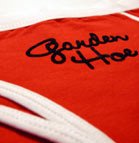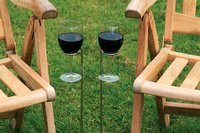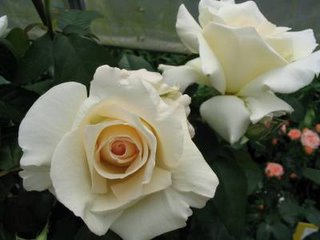Christmas and Hanukkah are right around the corner! It's time to get shopping, so to save you some stress, here's my list of the most desirable garden gifts:

The
Lucca Adjustable Lounge Armchair, from
Design Within Reach would look fabulous on the third-floor deck of our townhouse.

It's nerdy, but I've always wanted to get a
shiitake mushroom log and grow my own. From
Amazon.

What to do about garden lighting... I know! How about these inconspicuous
rock lights from
Canadian Tire?

One of
Fortune magazine’s 25 Best Products of 2004, the
Egg Birdfeeder is "handcrafted of ceramic earthenware that is cast, glazed and fired...the birdfeeder’s glossy-surfaced egg shape prevents squirrels from getting a grip, appropriately melding beauty and function." At
Design Within Reach.

This is neat. It's a seed keeper, described as "the ultimate seed saving device." It's comprised of a binder, plastic sleeves with zip locks to keep moisture out and the seeds in (so they won't be lost even if they do rattle out of the envelopes), and a pack of envelopes (self-sealing and reusable) to save your own seeds or to repackage those from other sources. At
Lee Valley Tools.
Also from
Lee Valley Tools, I'd love some tools to help me expand my floristry repertoire. Garden tools = plenty. Indoor tools = not so much. This
set of two florist tools - a stem stripper and design snips - would really go a long way in restoring the balance. While you're there, pick me up
a good frog or two.

In addition to renewals of my current magazine subscriptions, I'd love a year or two worth of
Garden Design. Sigh... now I just need time to read them all.

I love these
Garden Hoe panties, from
You Grow Girl. They also carry garden-themed t-shirts, pins, stationery, and lots of other neat things.
Guys, score major points with your lady by planning a weekend away. Maybe combine a stay at a nice B&B with a visit to a garden. Or, ladies, if your husband is just as likely to stick a fork in his eye as agree to that, plan a weekend with the girls! From Vancouver, great weekend getaways include
Heronswood,
Milner Gardens, or
Tofino Botanical Gardens.

These
pink Wellington boots are not only practical AND fabulous, but partial proceeds go to a great cause:
The Susan G. Komen Breast Cancer Foundation.
No one should be without the
CobraHead. I already have one, but if your giftee is without, I swear they will love this all-purpose hand tool. Promise.
I don't have an
indoor composter though.
Nature Mill makes one that looks brilliant. At $399, you can really show how much you care.

The Royal Horticultural Society's
online store has tons of sweet stuff. I love these organic-looking
bird feeders, though it's more likely they'd end up as mere garden ornaments because I couldn't fill them as fast as they'd be emptied.

Not nearly as frivolous, these
wine glass holders are a must-have, if silly, item. For all those times you're lounging about on the lawn. Ha!

Despite what the
Garden Gnome Liberation Front would have you believe, I bet your favourite corporate slave needs a
Desktop Gnome. Available through
Jackson and Perkins, the little guy comes complete with interchangeable backdrops, four whole "arrangeable" flowers and a full-color book on the history and lore of gnomes.
Also from
Jackson and Perkins, I like this
rosemary bonsai tree. Edible and pretty, but for some reason I want to remove the flowers.
And finally, there's always gift certificates - to any of the above online retailers, or to local specialty nurseries. I'd love one for Thomas Hobbs'
Southlands Nursery, or
Phoenix Perennials.
Check back frequently. I'll update this list as I discover new gift ideas.






























